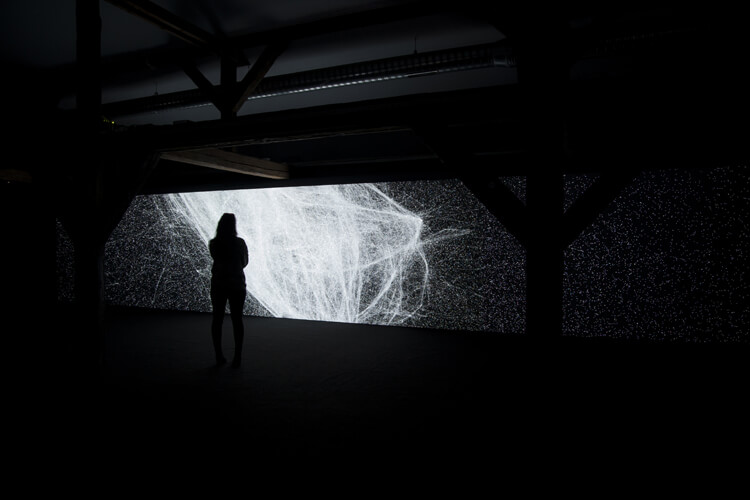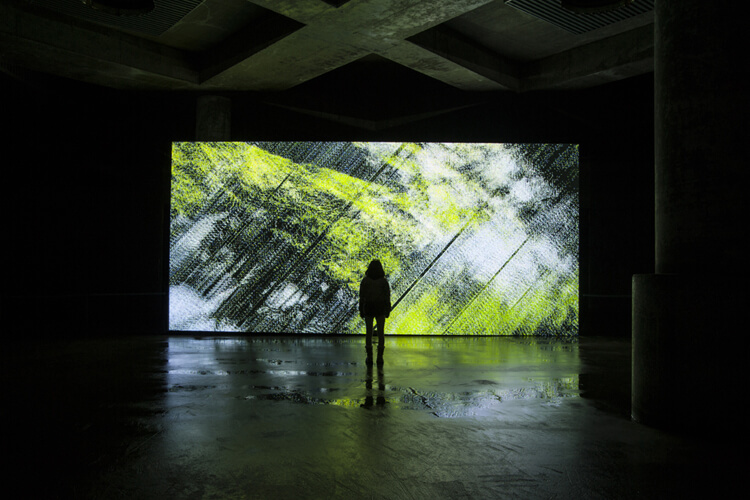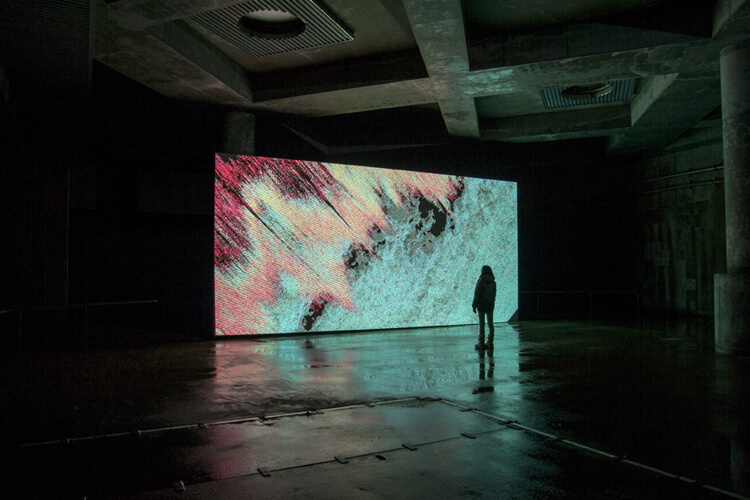Words by Patricia Bondesson Kavanagh

Looking at the artwork datum from 2017 by Japanese media artist Norimichi Hirakawa, the viewer is presented with an audiovisual installation consisting of a dazzling array of pixels. Viewed in a darkened room, what appears on the projected screen teeters on the edge of becoming representational without ever fully toppling over the brink and into the fully figurative.
The abstractions, accompanied by a dissonant score programmed by Satoshi Hama, consist of colours coming together in a digitalised cacophony. The imagery forms waves, morphing into alien topographies before momentarily taking on the likeness of an iridescent landscape or a geometric shape before inevitably dissipating again into the swarm of ever-changing pixels.
These forms are in line with Hirakawa’s ongoing practice of producing audiovisual installations through real-time processed computer programming, situating pixels in the higher Euclidean dimensions. In this unorthodox way, technology can be utilised to question traditional concepts such as beauty and sublimity.
datum has been exhibited in various locations, from Moerenuma Park and the Yuataka Kikutake Gallery in Japan to the WRO Art Center in Poland (which recently hosted a Hirakawa solo exhibition). The work was the result of the cooperation between the artist and the Kavli Institute for the Physics and Mathematics of the Universe (Kavli IMPU). The collaboration was part of their Artist-in-Residency program (AIR) and represented an interdisciplinary effort to bring together artists and scientists in unique ways while at the same time exposing the public to scientific research, often excluded for being too complex and theoretical.
We can see the art-science binary is a recurring theme in Hirakawa’s work, both philosophically and practically. Theoretically, it manifests itself in the juxtaposition between human imagination and the imaginative potential of coding. The limits of the former are challenged by the prospective boundlessness of the latter, for while algorithms may be controlled by people, the visuals they may render can often be unexpected and beyond what we imagine in our mind’s eye.
Hirakawa also works with the relationship between art and science in a more practical way as the artistic director of the ARTSAT project – the art and satellite project – which views low-orbit satellites as a medium between earth and space. It not only utilises the field between art and science as a catalyst for creative exchange but the very objects which navigate the place between earth and space for analogous artistic fuel. It truly is space exploration.


You have just finished a residency program at Kavli IPMU. How do you think this residency will reshape the way you approach the art form?
Kavli IPMU is a scientific institution mainly based on theoretical fields such as theoretical physics, quantum physics, string theory and mathematics. One of the facts I became aware of after the residency is the impossibility of translation between art and science. Although both art and science are systems which are not inventive in purpose(unlike technology and design), there is still a big difference in their purpose. Science is to describe the universe. Art is to sense the world. We should not mix them up.
I have been trying to get rid of scientific meaning in my artwork. Indeed, there is no scientific meaning. But at the same time, I keep using mathematical methods in my project to guarantee objectivity. I would say it’s visibly logical. Mathematics makes a difference in the same meaning as the camera made for the painters at the time it was invented. I became to think of mathematics in this way.
You told us in one of your emails that your objective is not technology but science. Could you tell us a little bit about the intellectual process behind your work?
All of the processes behind my work are actually written in my code, a computer program. A computer program is a technology, of course. But also you will understand one thing when you realize that one algorithm can be written in some different programming languages, that the most fundamental technology is not the computer programing but the algorithm itself, which is the most primitive technology ever achieved by a human being who is capable to handle symbols.
I try not to think about the eventual visual of the artwork at the beginning of the creation. I only think about the logic in my code. This step pushes the artwork up beyond my imagination. One of my mentors said human is not able to create either something you can not imagine or something you have never seen. I think it’s true. and I’m trying to make something I have never seen or something I can not imagine. Not quite sure if it is intellectual or not, just because there are so many definitions of intelligence. Anyhow, this is my motivation to make artwork with technology.
datum is a project that started after the residency program at Kavli IPMU, and it approaches the border between human-perceptible and human-imperceptible beauty. What was the biggest challenge you faced in its development?
The idea of datum is putting all of the pixels in a movie data into 6-dimensional Euclidean space, which consists of X, Y, R, G, B and T. This makes it possible to deal with space, colour and time at the same time even though they are different concepts in art. X and Y coordinate on the screen. R, G, and B are the values of the colour of the pixel, and T is the location in time, such as a frame number or time code.
The actual operation of Datum in that 6-dimensional Euclidean space is rotation. Any rotation in n-dimensional Euclidean spaces can be decomposed into a combination of rotations in a plane. There are fifteen kinds of rotation in this 6-dimensional space. Space-Space(XY), Space-Color (XR, XG, XB, YR, YG, YB), Space-time (XT, YT), Color-color(RG, RB, GB) and Color-time(RT, GT, BT). I tried all of those with several hundreds of different pictures to understand how the result could be. It was unimaginably difficult to get some sense of the rotation in the planes in different kinds of dimensions like space colour.
For example, the rotation of a pixel in an image file on the plane “XR” translates the horizontal location of the pixel to the value of red of the pixel. Even though it’s logically understandable when I think about just one pixel, the result of the whole image in a movie is not really respectable.
How people respond to multiple stimuli in a digital environment beyond the touch of a screen or button is one of the questions to answer in this 21st century in which people live in a hyper-connected society. In which ways do you think are interactive and digital technologies changing or affecting human behaviour?
In no way, essentially. We still love to drink, eat, have sex and sleep.
What is your chief enemy of creativity?
Satisfaction.
You couldn’t live without…
Satisfaction.






